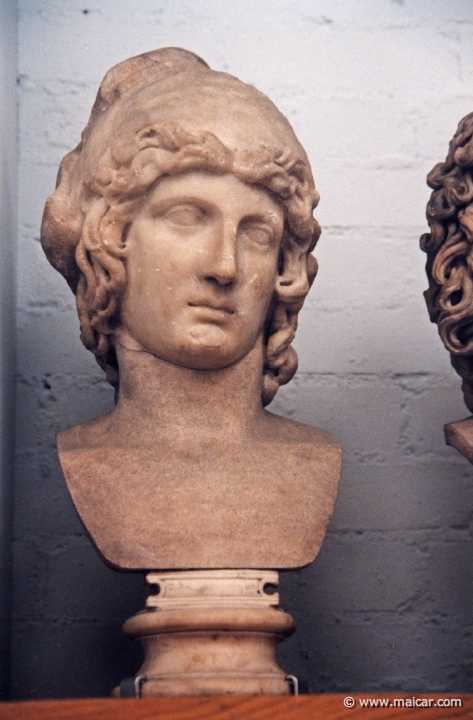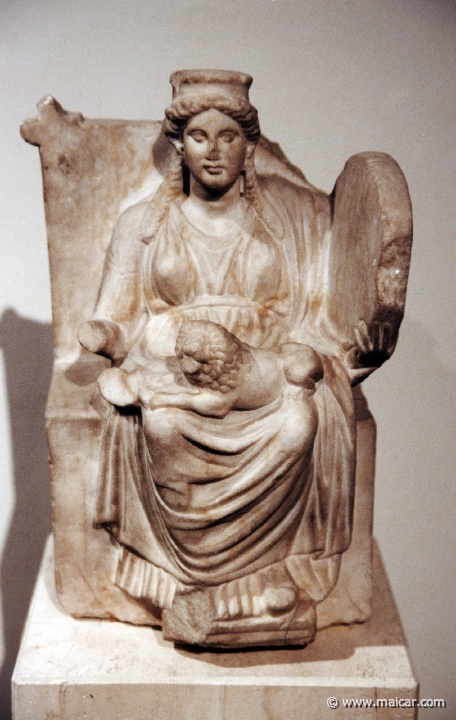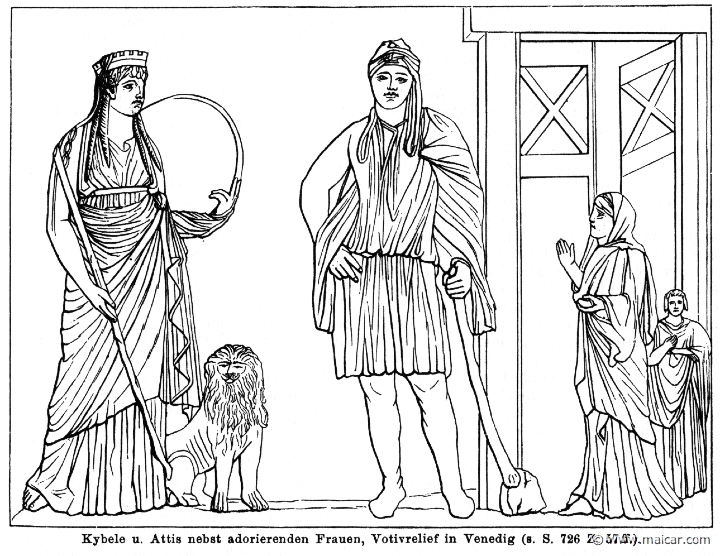|

|
8002: Attis. Marble, 2nd. century AD. British Museum, London.
|
|
Attis was a Phrygian or a Lydian dear to Cybele.
He is remembered for having cut off his genitals in
a fit of folly. Some say that at his death he was
turned into a pine tree, but even more
extraordinary is his birth.
Belief today and yesterday
Not few believe that people of ancient times were like children, and not at all so clever as modern man. And since technological advance is their clue and indicator, they are persuaded that humanity easily discards the beliefs and fantasies of the past, as its mental sanity is increased by a larger amount of verifiable facts. So for example, says the distinguished anthropologist James G. Frazer, 1854-1941:
"The belief in the possible impregnation of women without sexual intercourse appears to have been common, if not universal, among men at a certain stage of social evolution, and it is still held by many savages." (James G. Frazer. Note to Apollodorus 1.3.5.).
However, there are those in contemporary society who could not be called savages and yet assert that Mary, the mother of Jesus, conceived her child without regular sexual intercourse.
How Attis was conceived
Now the myths, which have less to do with belief than some would think, affirm that the daughter of the god of the Sangarius river, which flows in Asia Minor into the Black Sea, conceived Attis not by sexual intercourse, but by taking the fruit of an almond tree that had grown up from the sexual organ of Agdistis, which the gods had cut off.
Agdistis
Agdistis, who was a demon with both male and female sexual organs, was born from the seed that Zeus once let fall upon the ground when he was asleep. But since his double sexuality frightened the gods, they cut off Agdistis' male organ. From Agdistis' amputated organ then, an almond tree grew up with its fruit ripe; and when Sangarius' daughter came along, they say, she took of the fruit and laid it in her bosom and, on doing this, the fruit disappeared and she found herself pregnant.
|

|
The Mother of The Gods, called Agdistis and Cybele, and identified with Rhea 1, the wife of Cronos. 3413: Statyette der Göttin Kybele. Griechisch 330-300 v. Chr. Museum für Kunst und Gewerbe, Hamburg.
|
|
Castration at wedding party
When some time after a boy was born she exposed him, but he was saved by a goat that nourished him. And when years later Attis became a youth of beauty more than human, he was sent by some relatives to Pessinus in central Asia Minor near Mount Dindymus, to marry the king's daughter. However, when the wedding ceremony was being celebrated and all were singing, Agdistis made a sudden appearance, whereupon Attis, losing his mind, cut off his own genitals; and so did the king too.
Attis buried
When this happened, Agdistis repented and asked Zeus to grant that Attis' body should not decay; for as they say, Agdistis was himself in love with the youth. But whatever happened to that request, Attis was buried in the vicinity of Pessinus, where a temple was built to the Mother of the Gods, whom they called Agdistis although she is often identified with Rhea 1, Cronos' wife.
Attis love for Sagaritis
Others have said that Attis was a worshipper of the Mother of the Gods, and that the goddess asked him to guard her temple and keep his chastity, whereupon he promised obedience saying:
"If I lie ... may the love for which I break faith be my last love of all." (Ovid, Fasti 4.227).
And since promises are more often than not broken, Attis met the Naiad Sagaritis and turned her into his sweetheart. But the Mother of the Gods, who was well informed, by wounding the Naiad's tree destroyed Attis' sweetheart as well, since her fate was dependent on the tree's. This event, they say, and nothing else, is the reason why Attis lost his mind, imagining that his chamber's roof was falling in.
Attis goes mad
So being completely mad, Attis ran to the top of Mount Dindymus, uttering such words that let understand that he was seeing the ERINYES. Then he mangled his body with a sharp stone, and trailed his hair in the dust, crying as he tortured himself that he had deserved what he was going through. Then he shouted repeatedly:
"Ah, perish the parts that were my ruin." (Ovid, Fasti 4.240).
whereupon he cut off his genitals. Then Attis turned into a pine-tree, which is why this tree is pleasing to the Mother of the Gods.
Born an eunuch and killed by a boar
Still others say that Attis was son of the Phrygian Calaus and eunuch from birth. Attis became known, they say, when he, after migrating to Lydia instructed his hosts in the orgies of the Mother. But the Lydians, for loving Attis and the Mother so much, had their tillage destroyed by a boar sent by Zeus; and this animal, they tell, killed Attis in addition to some Lydians.
|

|
Cybele (Rhea 1) with the lion at her feet, Attis holding a shepherd's staff, and worshippers. RI.1-0725: Cybele, Attis, and worshippers. Votive relief in Venice. Roscher, Lex. 1884.
|
|
The Mother goes to Rome
Later, at the time when Attalus was king of Phrygia, which is about 200 BC, the Mother of the Gods was brought to Rome, following the instructions of the Sibyl at Cumae and the Oracle at Delphi. It is said that when the king at first refused the favor to the Roman envoys, the voice of the goddess herself was heard saying these prophetic words:
"It was my own will that they should send for me ... let me go, it is my wish. Rome is a place meet to be the resort of every god." (Ovid, Fasti 4.269).
Successful priesthood
When the Mother of the Gods had spoken, Attalus, understanding that Rome traced its origin to Aeneas and Phrygian ancestors, let the envoys take the goddess, whose image was embarked in the Hellespont, the strait in northwestern Asia Minor, and came to the mouth of the Tiber, Rome's river, some time later. For this reason the Asian temple became famous where the Mother of the Gods was venerated. She was in Asia called Agdistis, and being the object of great devotion, the priests, they say, achieved extraordinary prosperity, living as potentates.